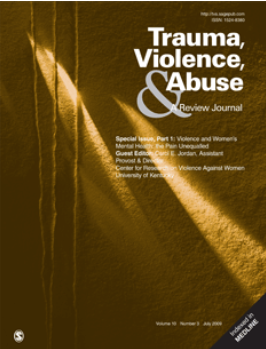Protective and Promotive Factors in Migrant and Refugee Children Facing Violence: A Systematic Review
IF 5.4
1区 社会学
Q1 CRIMINOLOGY & PENOLOGY
引用次数: 0
Abstract
Migrant and refugee children are at risk of experiencing various forms of violence before, during, or after migration. This study systematically identifies, reviews, and synthesizes evidence on protective and promotive factors that contribute to the resilience of migrant and refugee children facing violence. Of the 3,663 articles identified through search in five electronic databases and snowball technique, 31 quantitative or qualitative research studies met the inclusion criteria. To be included in the review, studies had to (1) have been published after 2013; (2) have been published in English; (3) include migrant or refugee children and/or adolescents aged 18 or below at the time of interview or migration; (4) mention some types of maltreatment, peer violence, or community violence faced by the children or adolescents; (5) examine the association between the hypothesized protective or promotive factors and indicators of adaptive functioning; and (6) include outcome measures that assessed adaptive functioning such as well-being or absence or low-levels of internalizing and externalizing problems. Quality assessment did not lead to the exclusion of any studies. Five levels of protective and promotive factors were identified: individual, family, school and peers, community, and spatial dimension, which converged to highlight the importance of regulatory, interpersonal, and meaning-making strengths for these children. Understanding and addressing these protective and promotive factors is crucial for promoting well-being and improving mental health outcomes in migrant and refugee children facing violence. The findings of this review have significant implications for designing intervention programs and public policies that support these children effectively.面临暴力的移民和难民儿童的保护和促进因素:系统回顾
移民和难民儿童在移民前、移民期间或移民后都有可能遭受各种形式的暴力。本研究系统性地识别、回顾和综合了有助于移民和难民儿童面对暴力时提高适应力的保护性和促进性因素的证据。通过五个电子数据库的搜索和滚雪球技术确定了 3,663 篇文章,其中 31 项定量或定性研究符合纳入标准。要纳入综述,研究必须:(1)发表于2013年之后;(2)以英语发表;(3)包括受访或移民时年龄在18岁或以下的移民或难民儿童和/或青少年;(4)提及儿童或青少年所面临的某些类型的虐待、同伴暴力或社区暴力;(5) 研究假设的保护性或促进性因素与适应功能指标之间的关联;以及 (6) 包括评估适应功能的结果测量,如幸福感或无或低水平的内化和外化问题。质量评估没有导致任何研究被排除。研究确定了五个层面的保护和促进因素:个人、家庭、学校和同伴、社区以及空间维度,这些因素共同强调了调节、人际交往和意义建构力量对这些儿童的重要性。了解并解决这些保护性和促进性因素,对于促进面临暴力的移民和难民儿童的福祉并改善其心理健康结果至关重要。本综述的研究结果对于设计有效支持这些儿童的干预计划和公共政策具有重要意义。
本文章由计算机程序翻译,如有差异,请以英文原文为准。
求助全文
约1分钟内获得全文
求助全文
来源期刊

Trauma Violence & Abuse
Multiple-
CiteScore
13.60
自引率
7.80%
发文量
131
期刊介绍:
Trauma, Violence, & Abuse is devoted to organizing, synthesizing, and expanding knowledge on all force of trauma, abuse, and violence. This peer-reviewed journal is practitioner oriented and will publish only reviews of research, conceptual or theoretical articles, and law review articles. Trauma, Violence, & Abuse is dedicated to professionals and advanced students in clinical training who work with any form of trauma, abuse, and violence. It is intended to compile knowledge that clearly affects practice, policy, and research.
 求助内容:
求助内容: 应助结果提醒方式:
应助结果提醒方式:


